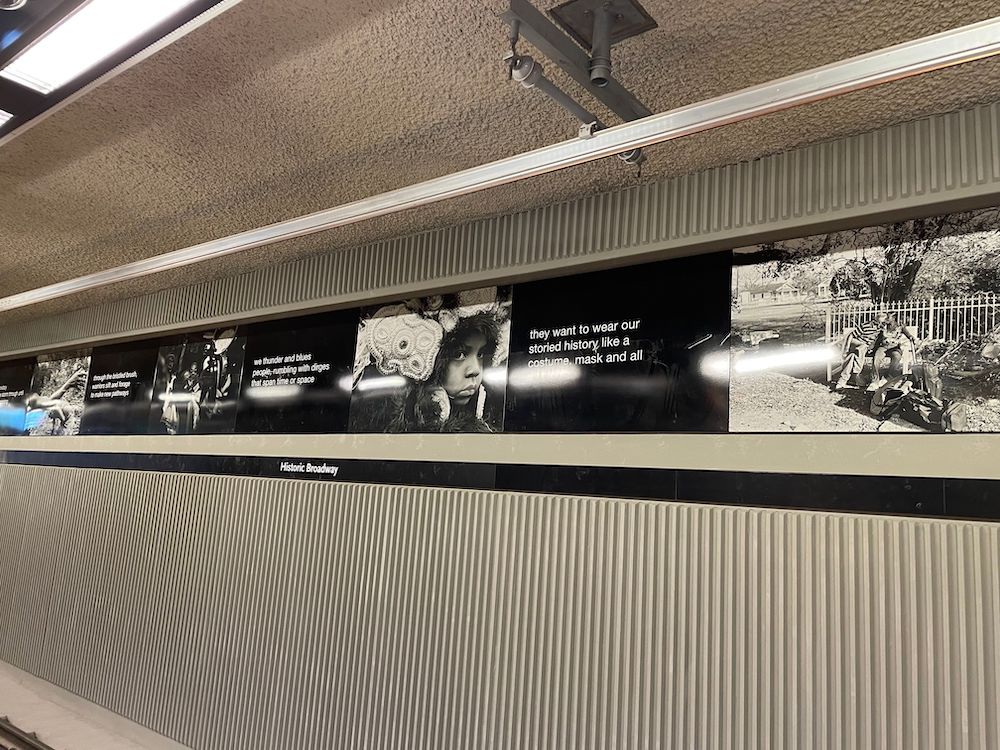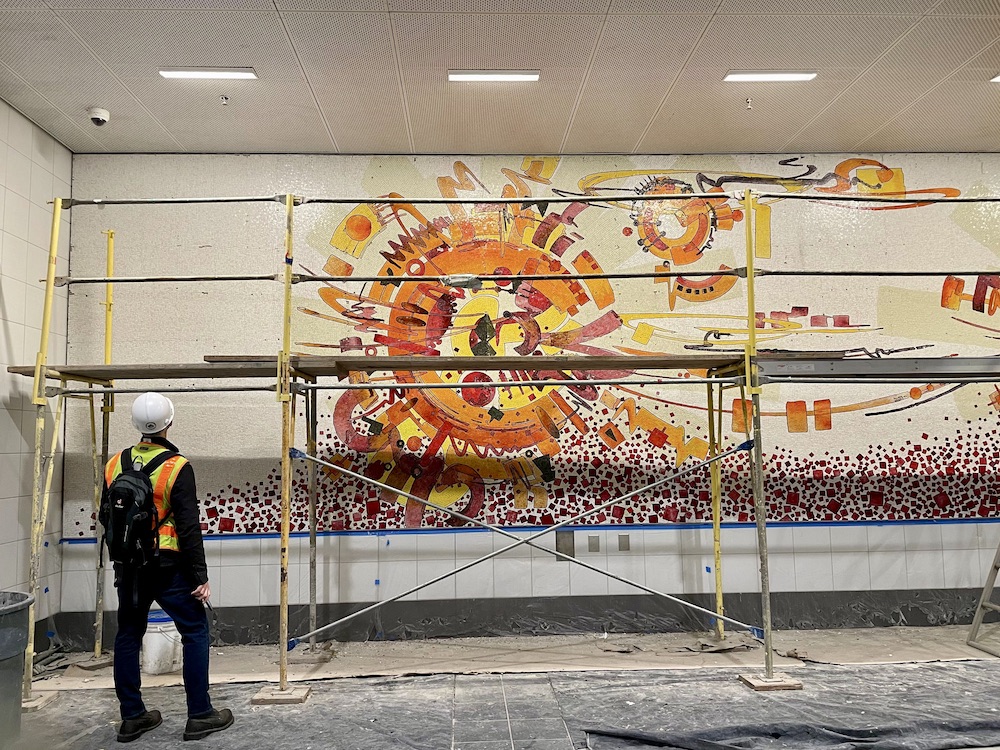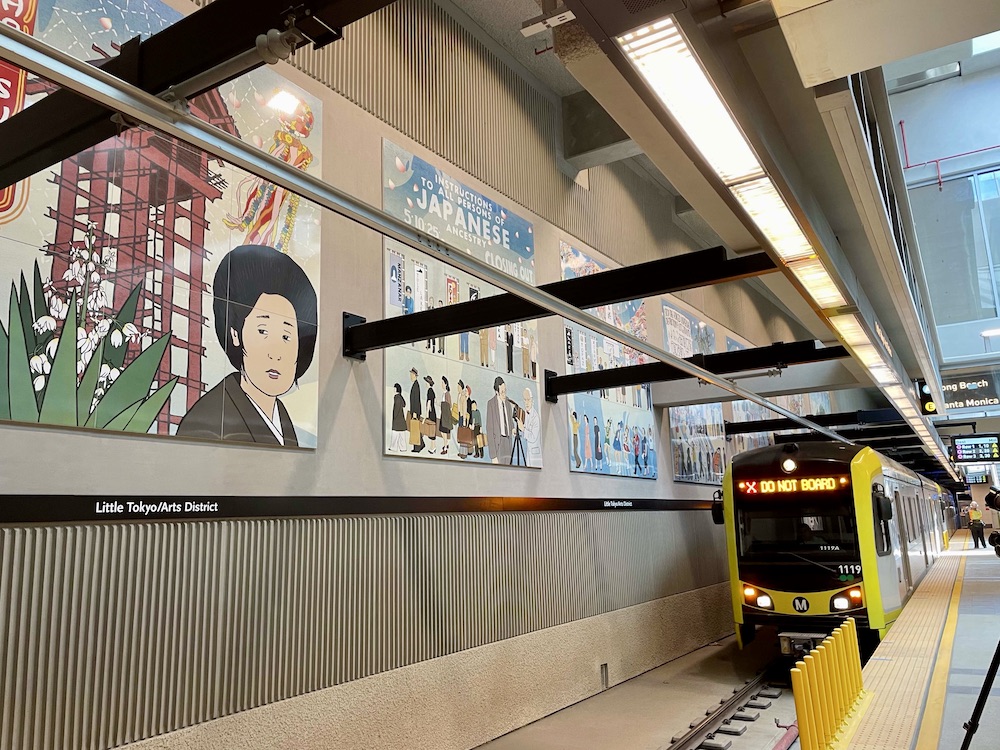The Regional Connector will open June 16, and it’s really good news for those of us who take Metro, because it will reduce time and station changes in getting around on LA’s ever-expanding light rail. I’m also looking forward to the public art—some of the most ambitious projects yet—that will distinguish three new stations that connect Union Station to 7th Street/Metro Center Station.
Having lived in cities with extensive light rail systems (Washington, DC, Tokyo, Hong Kong), I love good public transportation. They are not only an efficient and affordable means of transportation in spread-out cities, they are also places for meeting and gathering, dissemination of information, and public art. The art provides pauses and markers of time and space, offering doses of visual delight, kernels of thought and reminders of local and regional culture and history. In this latter role, they can help elevate civic life and community.
The three new stations will feature eight site-responsive art installations commissioned by Metro and include a number of well-known artists from Southern California, as well as Ann Hamilton, the noted installation/performance artist based in Columbus, Ohio. To learn more about Metro Art, I spoke with Zipporah Yamamoto, senior director of special projects in the Metro Art program. She explains that 40 years ago the Board of Metro’s predecessor agency decided on a “percent for art” program; a program which sets aside a portion of construction costs for transit capital projects, to be used for public art.

“Under construction view (detail) of Clarence Williams’, “Migrations,” at Historic Broadway Station.
“We try to make that half percent go as far as possible,” says Yamamoto. “We do that by getting involved early on in the project, and look at the project and how it’s evolving, and how we can work closely with the architects and the design team to get the most impact for riders.” In 2014 there was a call to artists to apply to get qualified for consideration. Then a panel of art professionals reviewed those qualified and ranked them according to a set rubric; the most highly ranked were invited to submit proposals for specific stations. At this point materials would be identified by Metro Art staff—materials like glass, porcelain enamel steel and mosaic which would withstand the wear and tear of exposure. “All of the artists who were finalists were also paid to develop those proposals, and to make a presentation to the panel,” says Yamamoto. “We don’t ask artists to develop proposals for things for free.”

Under construction view (detail) of Andrea Bowers’s, “The People United (“El pueblo unido jamás será vencido,” Sergio Ortega and Quilapayun; “Brown Beret 13 Point Political Program,” La Causa),” at Historic Broadway Station
After a proposal was approved, artists would go into a more detailed design and development phase, with more time to get to know the community and geography. Artists Audrey Chan and Pearl C. Hsiung conducted outreach and workshop programs; Mark Steven Greenfield worked with the California State University, Los Angeles Alumni Association to send out a survey about the Red Car, an earlier light rail system that served the region that would be the subject of his project.
The results have been vibrant and varied. The Little Tokyo/Arts District station will feature Clare Rojas’ Harmony with its abstracted landscape and Audrey Chan’s Will Power Allegory made up of 14 panels with colorful vignettes of people from the Arts District, Skid Row, Bronzeville and Gabrielino/Tongva Tribe. The Historic Broadway station will feature Andrea Bowers’ “The People United (“El pueblo unido jamás será vencido,” Sergio Ortega and Quilapayun; “Brown Beret 13 Point Political Program,” La Causa),” Mark Steven Greenfield’s Red Car Requiem and Clarence Williams’ Migrations. The Grand Avenue Arts/Bunker Hill station will feature Ann Hamilton’s over-under-over with a pattern inside and outside an elevator tower, Pearl C. Hsiung’s 60-foot tall glass mosaic, High Prismatic and Mungo Thomson’s Negative Space (STScI-2015-02).

Under construction view of Mark Steven Greenfield’s, “Red Car Requiem,” at Historic Broadway Station
Don’t forget the fun places you can go with the Connector—Little Tokyo boasts a slew of Japanese restaurants and shops—be sure to check out the Japanese sweets shop Fugetsu-do and popular ramen restaurants on First Street; the Japanese American National Museum, next to MOCA Geffen, is across from the metro stop and award-winning East West Players has its theater nearby. The Arts District with its art galleries, including mega-gallery Hauser & Wirth, are within walking distance. Grand Avenue Arts/Bunker Hill station will let you out steps from The Broad museum and Disney Concert Hall, with the Music Center and its three theaters only a couple blocks away.
Many more infrastructure projects are on the horizon. To learn more about opportunities with Metro Art, visit metro.net/art and click on Art Opportunities.


